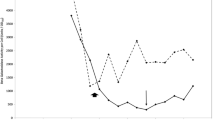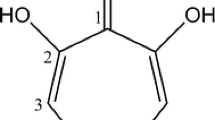Abstract
Bioluminescence and the synthesis of luciferase inVibrio harveyi growing in a minimal medium are repressible by iron; this is not significantly reversed by cyclic adenosine 3′,5′-monophosphate (cAMP). Cultures grown with added iron emit less light and possess less luciferase per cell than those grown under conditions of limiting iron; this may have significance in relation to the function of luciferase as an electron carrier. With iron, and with glycerol as the sole carbon and energy source, the addition of glucose causes further repression, both transient and permanent, and this is only partially reversible by cAMP. Without iron, glucose addition results in only a small and transient repression, but this is fully reversible by cAMP. The inability of cAMP to reverse iron-influenced repression may be explained by both a low rate of transport of cAMP into the bacteria and increased intracellular levels of cyclic nucleotide phosphodiesterase.
Similar content being viewed by others
Literature Cited
Baumann, L., Bang, S. S., Baumann, P. 1980. Study of relationship among species ofVibrio, Photobacterium, and terrestrial enterobacteria by an immunological comparison of glutamine synthetase and superoxide dismutase. Current Microbiology4:133–138.
Baumann, P., Baumann, L., Bang, S. S., Woolkalis, M. J. 1980. Reevaluation of the taxonomy ofVibrio, Beneckea, andPhotobacterium: Abolition of the genusBeneckea. Current Microbiology4:127–132.
Hastings, J. W., Weber, G. 1963. Total quantum flux of isotropic sources. Journal of the Optical Society of America53:1410–1415.
Lin, P., Saier, M. H., Nealson, K. H. 1976. Regulation of the synthesis of the bioluminescent system inBeneckea harveyi. Federation of American Societies for Experimental Biology Proceedings35:1361.
Lowry, O. H., Rosebrough, N. J., Farr, A. L., Randall, R. J. 1951. Protein measurement with the Folin phenol reagent. Journal of Biological Chemistry193:265–275.
Makemson, J. C., Hastings, J. W. 1979. Poising of the arginine pool and control of bioluminescence inBeneckea harveyi. Journal of Bacteriology140:532–542.
Mitchell, G. W., Hastings, J. W. 1971. A stable, inexpensive, solid state photomultiplier photometer. Analytical Biochemistry39:243–250.
Nealson, K. H., Eberhard, A., Hastings, J. W. 1972. Catabolite repression of bacterial bioluminescence: Functional implications. Proceedings of the National Academy of Sciences of the United States of America69:1073–1076.
Nealson, K. H., Hastings, J. W. 1979. Bacterial bioluminescence: Its control and ecological significance. Microbiological Reviews43:496–518.
Nealson, K. H., Platt, T., Hastings, J. W. 1970. Cellular control of the synthesis and activity of the bacterial luminescent system. Journal of Bacteriology104:313–322.
Ulitzur, S., Hastings, J. W. 1979. Control of aldehyde synthesis in the luminous bacteriumBeneckea harveyi. Journal of Bacteriology137:854–859.
Ulitzur, S., Yasphe, J. 1975. An adenosine 3′, 5′-monophosphate-requiring mutant of the luminous bacteriaBeneckea harveyi. Biochimica et Biophysica Acta404:321–328.
Author information
Authors and Affiliations
Rights and permissions
About this article
Cite this article
Makemson, J.C., Hastings, J.W. Iron represses bioluminescence and affects catabolite repression of luminescence inVibrio harveyi . Current Microbiology 7, 181–186 (1982). https://doi.org/10.1007/BF01568972
Issue Date:
DOI: https://doi.org/10.1007/BF01568972




